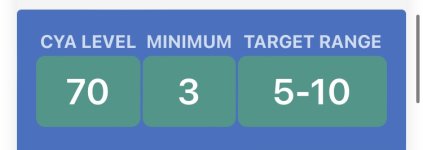I have only one full Summer under my belt and I expected I could follow the same pattern and levels of SWC generation this Summer. So far, that is not true and I am suspecting a problem.
In early May, the pool was a bit cloudy and the Chlorine level was down to 1.2ppm. I cranked the unit up to 100% but not much changed. I shocked the pool on 5/16/23 with 2.5 gallons of liquid Chlorine (Pinch-a-Penny). That cleared up the cloudiness. I also had the company come out and test the IC60. It tested fine with only "500 hours on it". I had the tech remove the unit so I could inspect the plates. They were clean.
The levels slowly dropped again so I shocked the pool again on 6/21/23. I have been running the generator at 80% for 7 hours a day since late Spring. In order to keep the levels up, I am having to add liquid Chlorine every few days.
If the unit tests out OK, could the power center/logic unit have a problem? I have an Intellitouch I9+3 with the power unit built in.
Needless to say I have opened a support call with Pentair and the Installing dealer.
Current chemistry:
FC:2.1
pH:7.5
TA:60
CH:260
CYA:75
Salt:3100
Borates:50
I just added 5# of baking soda to raise the TA.
In early May, the pool was a bit cloudy and the Chlorine level was down to 1.2ppm. I cranked the unit up to 100% but not much changed. I shocked the pool on 5/16/23 with 2.5 gallons of liquid Chlorine (Pinch-a-Penny). That cleared up the cloudiness. I also had the company come out and test the IC60. It tested fine with only "500 hours on it". I had the tech remove the unit so I could inspect the plates. They were clean.
The levels slowly dropped again so I shocked the pool again on 6/21/23. I have been running the generator at 80% for 7 hours a day since late Spring. In order to keep the levels up, I am having to add liquid Chlorine every few days.
If the unit tests out OK, could the power center/logic unit have a problem? I have an Intellitouch I9+3 with the power unit built in.
Needless to say I have opened a support call with Pentair and the Installing dealer.
Current chemistry:
FC:2.1
pH:7.5
TA:60
CH:260
CYA:75
Salt:3100
Borates:50
I just added 5# of baking soda to raise the TA.





